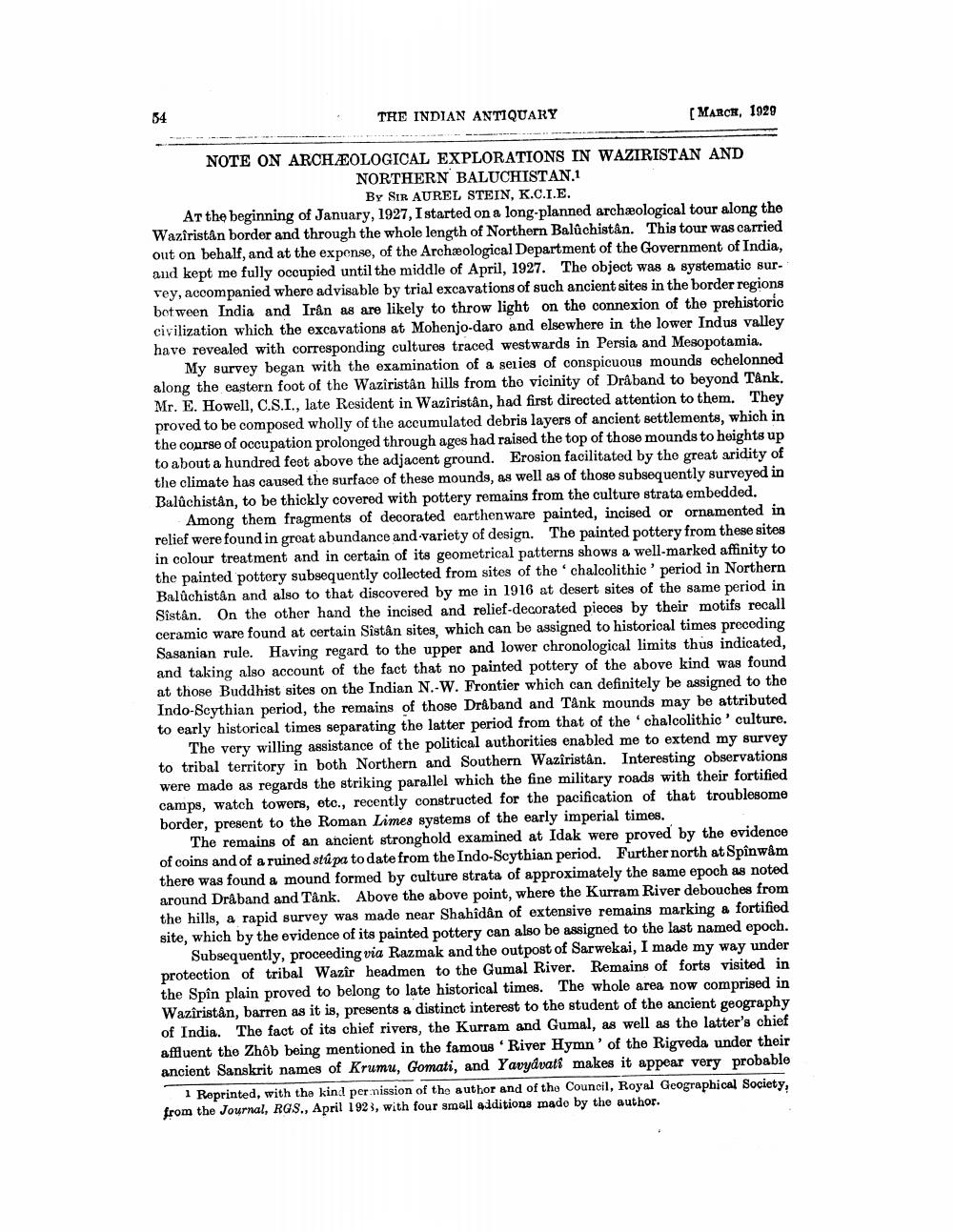________________
THE INDIAN ANTIQUARY
[MARCH, 1929
NOTE ON ARCHÆOLOGICAL EXPLORATIONS IN WAZIRISTAN AND
NORTHERN BALUCHISTAN.1
BY SIR AUREL STEIN, K.C.I.E. At the beginning of January, 1927, I started on a long-planned archæological tour along the Wazîristân border and through the whole length of Northern Balûchistân. This tour was carried out on behalf, and at the expense, of the Archæological Department of the Government of India, and kept me fully occupied until the middle of April, 1927. The object was a systematic survey, accompanied where advisable by trial excavations of such ancient sites in the border regions between India and Irán as are likely to throw light on the connexion of the prehistoric civilization which the excavations at Mohenjo-daro and elsewhere in the lower Indus valley have revealed with corresponding cultures traced westwards in Persia and Mesopotamia.
My survey began with the examination of a series of conspicuous mounds echelonned along the eastern foot of the Waziristân hills from the vicinity of Dråband to beyond Tänk. Mr. E. Howell, C.S.I., late Resident in Waziristân, had first directed attention to them. They proved to be composed wholly of the accumulated debris layers of ancient settlements, which in the course of occupation prolonged through ages had raised the top of those mounds to heights up to about a hundred feet above the adjacent ground. Erosion facilitated by the great aridity of the climate has caused the surface of these mounds, as well as of those subsequently surveyed in Balûchistân, to be thickly covered with pottery remains from the culture strata embedded.
Among them fragments of decorated earthenware painted, incised or ornamented in relief were found in groat abundance and variety of design. The painted pottery from these sites in colour treatment and in certain of its geometrical patterns shows a well-marked affinity to the painted pottery subsequently collected from sites of the chalcolithic' period in Northern Baluchistan and also to that discovered by me in 1916 at desert sites of the same period in Sistân. On the other hand the incised and relief-decorated pieces by their motifs recall ceramic ware found at certain Sistân sites, which can be assigned to historical times preceding Sasanian rule. Having regard to the upper and lower chronological limits thus indicated, and taking also account of the fact that no painted pottery of the above kind was found at those Buddhist sites on the Indian N.-W. Frontier which can definitely be assigned to the Indo-Scythian period, the remains of those Dråband and Tank mounds may be attributed to early historical times separating the latter period from that of the chalcolithic' culture,
The very willing assistance of the political authorities enabled me to extend my survey to tribal territory in both Northern and Southern Waziristan. Interesting observations were made as regards the striking parallel which the fine military roads with their fortified camps, watch towers, etc., recently constructed for the pacification of that troublesome border, present to the Roman Limes systems of the early imperial times.
The remains of an ancient stronghold examined at Idak were proved by the evidence of coins and of a ruined stů pa to date from the Indo-Scythian period. Further north at Spînwâm there was found a mound formed by culture strata of approximately the same epoch as noted around Dråband and Tánk. Above the above point, where the Kurram River debouches from the hills, a rapid survey was made near Shahidân of extensive remains marking a fortified site, which by the evidence of its painted pottery can also be assigned to the last named epoch.
Subsequently, proceeding via Razmak and the outpost of Sarwekai, I made my way under protection of tribal Wazir headmen to the Gumal River. Remains of forts visited in the Spin plain proved to belong to late historical times. The whole area now comprised in Wazîristân, barren as it is, presents a distinct interest to the student of the ancient geography of India. The fact of its chief rivers, the Kurram and Gumal, as well as the latter's chief affluent the Zhob being mentioned in the famous River Hymn' of the Rigveda under their ancient Sanskrit names of Krumu, Gomati, and Yavydvati makes it appear very probable
Reprinted, with the kind per nission of the author and of the Council, Royal Geographical Society, from the Journal, RGS., April 1923, with four small additions made by the author.




